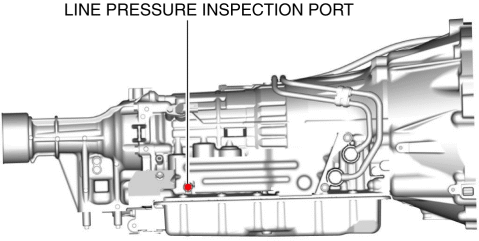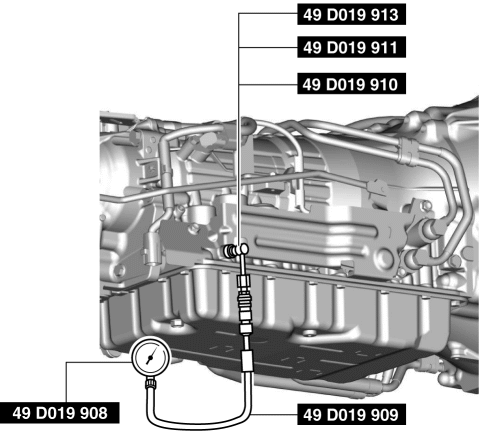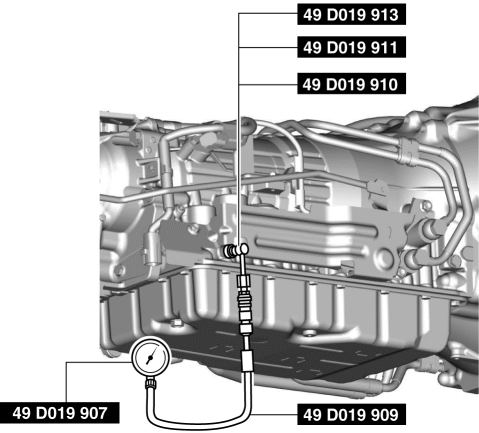MECHANICAL SYSTEM TEST [SJ6A-EL]
Mechanical System Test Preparation
1. Apply the parking brake firmly, and set the wheel blocks for both the front and rear wheels.
2. Inspect the engine coolant level. (See ENGINE COOLANT LEVEL INSPECTION [SKYACTIV-G 2.0].)
3. Inspect the engine oil level. (See ENGINE OIL LEVEL INSPECTION [SKYACTIV-G 2.0].)
4. Inspect the ATF level. (See AUTOMATIC TRANSMISSION FLUID (ATF) LEVEL ADJUSTMENT [SJ6A-EL].)
5. Inspect the idle speed. (See ENGINE TUNE-UP [SKYACTIV-G 2.0].)
6. Inspect the ignition timing. (See ENGINE TUNE-UP [SKYACTIV-G 2.0].)
Line Pressure Test
1. Perform mechanical system test preparation. (See Mechanical System Test Preparation.)WARNING:
Removing the square head plug when the ATF is hot can be dangerous. Hot ATF can come out of the opening and badly burn you. Before removing the square head plug, allow the ATF to cool.
NOTE:
Use a suitable oil pressure gauge that corresponds to the line pressure because the maximum scale value differs depending on the oil pressure gauge.
2. Remove the test plug and O-ring from the line pressure inspection port.
3. Install SSTs (49 D019 908, 49 D019 909, 49 D019 910, 49 D019 911, 49 D019 913) to the line pressure inspection port as shown in the figure.
4. Start the engine and warm it up until the ATF reaches 60—70 °C {140—158 °F}.
5. Shift the selector lever to the D position.
6. Measure the line pressure while idling in D position.
7. Measure the line pressures while idling in the M (1st gear) and R positions using the same procedure.
8. Stop the engine.
9. Change the low-pressure gauge ( 49 D019 908) to the high-pressure gauge ( 49 D019 907).
10. Start the engine.
11. Strongly depress the brake pedal with the left foot.
12. Shift the selector lever to the D position.CAUTION:
To prevent damage to the transmission, measure the line pressure while stalling (Step 13—14) within 5 s.
13. Slowly depress the accelerator pedal fully with the right foot all the way down.
14. Read the line pressure quickly while stalling, and remove the right foot from the accelerator pedal.
15. Shift the selector lever to the N position and idle for 1 min or more.
16. Measure the line pressure while stalling for positions other than D in the same procedure.
If there is any malfunction, one of the following causes may have occurred:
Line pressure
Condition
Possible cause
Higher in R, D, and M (1GR) position
Line pressure control solenoid malfunction
Primary regulator valve malfunction
Lower in R, D, and M (1GR) position
Line pressure control solenoid malfunction
Primary regulator valve malfunction
Oil pump malfunction
Lower in D position
Hydraulic circuit of D malfunction
C1 clutch malfunction
Lower in R position
Hydraulic circuit of R malfunction
C3 clutch malfunction
B4 brake malfunction
Measurement conditions
Specification (kPa {kgf/cm2, psi})
D and M (1GR) position
Idle
350—430 kPa {3.57—4.38 kgf/cm2, 50.8—62.3 psi}
Stall
900—1,080 kPa {9.18—11.01 kgf/cm2, 131.0—156.6 psi}
R position
Idle
760—950 kPa {7.75—9.68 kgf/cm2, 111—137 psi}
Stall
1,410—1,630 kPa {14.38—16.62 kgf/cm2, 204.6—236.4 psi}
WARNING:
Removing the square head plug when the ATF is hot can be dangerous. Hot ATF can come out of the opening and badly burn you. Before removing the square head plug, allow the ATF to cool.
17. Remove the SSTs.
18. Install the test plug and O-ring in the inspection port.Tightening torque
5.9—8.8 N·m {61—89 kgf·cm, 53—77 in·lbf}
Stall Speed Test
1. Perform mechanical system test preparation. (See Mechanical System Test Preparation.)
2. Start the engine.
3. Strongly depress the brake pedal with the left foot.
4. Shift the selector lever to the D position.CAUTION:
To prevent damage to the transmission, measure the line pressure while stalling (Step 5—6) within 5 s.
5. Slowly depress the accelerator pedal fully with the right foot all the way down.
6. Read the engine speed quickly when the speed is stabilized, and remove the right foot from the accelerator pedal.
7. Shift the selector lever to the N position and idle for 1 min or more.
8. Measure the stall speed in the M (1st gear) and R positions using the same procedure.
If there is any malfunction, one of the following causes may have occurred:
Engine stall speed
Condition
Possible cause
Lower in R, D, and M (1GR) position
Engine lack of power
Torque converter one-way clutch malfunction
Higher in D and M (1GR) position
Insufficient line pressure
C1 clutch malfunction (slippage)
F3 one-way clutch malfunction
Higher in R position
Insufficient line pressure
B4 brake malfunction (slippage)
C3 clutch malfunction (slippage)
F1 one-way clutch malfunction
Higher in R, D, and M (1GR) position
Insufficient line pressure
Oil leakage from each position circuit
Measurement conditions
Specification (rpm)
D, R, M
2,546—2,846
Time Lag Test
1. Perform mechanical system test preparation. (See Mechanical System Test Preparation.)
2. Start the engine.
3. Shift the selector lever from the N position to the D position with the brake pedal depressed.
4. Measure the time until the shift shock is felt firmly after shifting.
5. Measure the time lag from the N position to the R position using the same procedure.< Previous Next >
If there is any malfunction, one of the following causes may have occurred:
Condition
Possible Cause
N → D shift
Insufficient line pressure
C1 clutch malfunction (slippage)
F3 one-way clutch malfunction
N → R shift
Insufficient line pressure
C1 clutch malfunction (slippage)
C3 clutch malfunction (slippage)
F1 one-way clutch malfunction
Time lag
N position → D position: 0.7 s or less
N position → R position: 1.2 s or less


